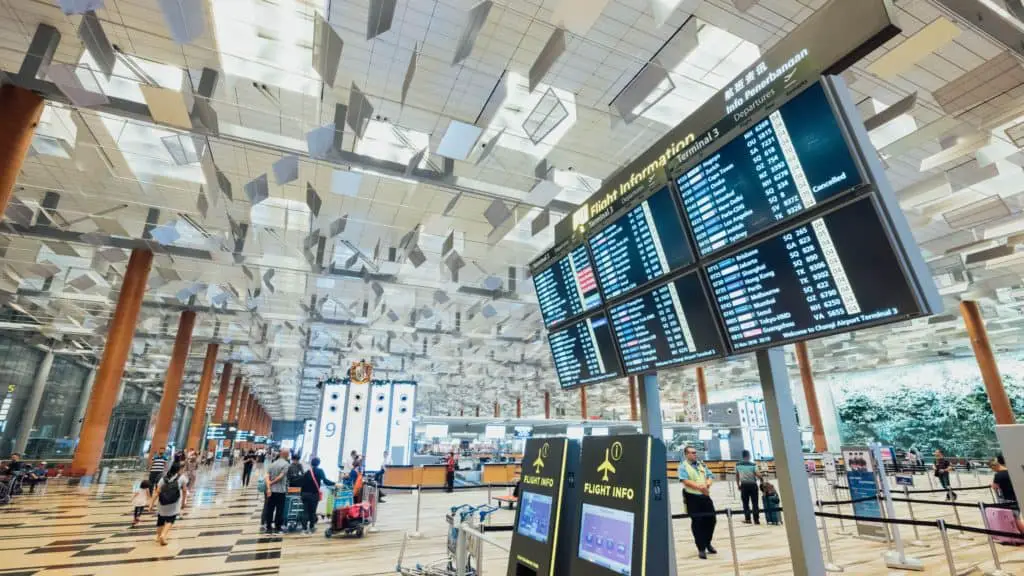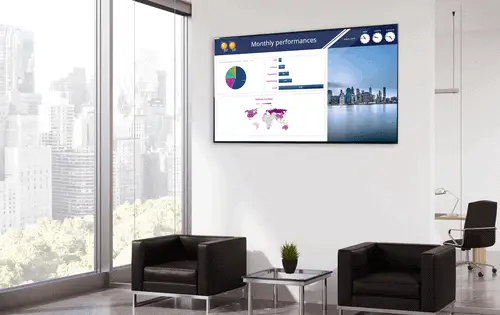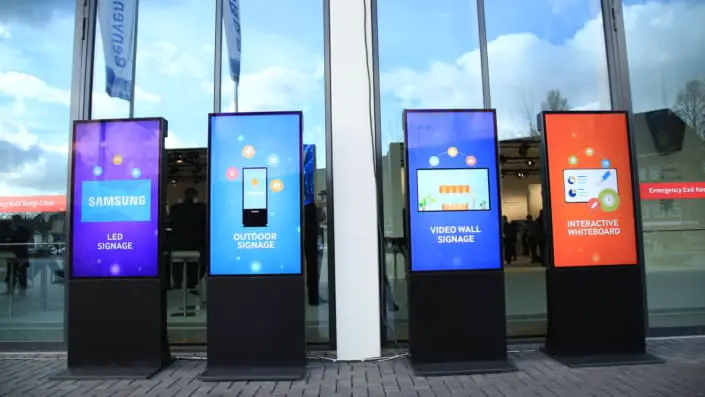This post contains affiliate links.
Technology continues to change every industry, improving on even the most simple concepts like signage. Some of the changes have become so subtle that it happens right before our eyes. Digital displays are popping up in almost every industry, from healthcare to retail, and even right under our noses' in our own homes.
A digital display is an electronic display that can be used in a variety of ways. Simply put, a digital display is one that isn't printed. Companies use digital displays to market directly to existing and future customers, and other businesses use these displays as a convenient way to keep their employees engaged and informed.
Digital displays have been around for years and have become more and more mainstream as the overall cost continues to decrease. Companies will continue to find innovative ways to incorporate digital displays that will increase sales.
What Exactly is a Digital Display
Many companies will use posters or billboards to create excitement with the expectation that printed signage will increase sales. But as time goes on, that same printed display is no longer fresh and exciting and does not produce the same results it once had.
To remain competitive, decision-makers have to decide when to replace the printed signage to get the same desired effect.
Updating a printed display is not a quick process. The content will be hashed out and the layout approved before it can be ordered. It could take weeks for it to arrive and then additional time for installation.
There are no guarantees that the displayed content will resonate with customers. If that display misses the mark, this process will begin again much sooner than expected.
The cost to continually change printed displays can be costly if done multiple times over the course of a year. Printed signage is beneficial in many ways but also restricting. A cost-effective alternative is to display content digitally by using screens instead of print.
The upfront costs to replace printed signage with digital will be higher. However, those costs will level off and, in many cases, will result in savings. Deciding to revise or change the content becomes a little easier when the decision-makers realize that there are no additional costs to do so.
On one hand, a digital display can be used in the same manner as a printed display would. Digital signage is fluid and flexible, and there are distinct differences compared to printed signage. Instead of using one image, the option exists to add several images that rotate as a scrolling image.
Videos and music can be added to create excitement and draw attention. Coupons or discount codes can be programmed to run at different times of the day or even on different days. Real-time data can be incorporated into the format and design of the content.
What's Included in a Digital Display?
Digital displays require a more extensive setup than printed signage because the upfront costs can be significant.
The screen is what sets this apart from printed displays. It can be tempting to buy the largest flatscreen TV you could find but consider the following before doing so.
Understand why you are switching to a digital display and what you want the result to look like. If this signage will be used as an employee communication tool, will the largest screen still be the best option?
A flatscreen TV is not the best choice. Instead, go with a commercial screen, such as high def LED OR LCD, in the 42″- 70″ range. Select one that can be displayed vertically or horizontally and has the ability to hookup the media player through an HDMI/ VGA cable. Content could even be displayed through a flash drive if compatible. This can run anywhere from a couple hundred to thousands of dollars.
This is also a great time to evaluate the current location to determine if it is the best choice. The size of the location will decide how large or small of a screen you should purchase. As the size of the screen increases, the customer viewing will need to increase too; otherwise, the content will be lost on the viewer.
These displays can be mounted on a portable cart so that it is easier to move from one location to the next. They can even be outside to withstand the elements.
Where it is mounted, it will need to be close to a power source and hardwired for the internet. The content management software (CMS) allows you to create the content, and the display will not work without access to both.
Where Can You Find Digital Displays?
Digital displays are more common than we realize- even the smartphone is a smaller version of one. Different content is displayed scrolling through the apps and home page. As small as smartphones can be, there is quite a bit of room to customize the display.
Here are some other examples of how digital displays are used in various industries.
Informational Text in Public Areas
- The next time you head to the airport to catch a flight, notice the screens that list all the arrivals and departures. That process would take too long if done manually, and communicating that information digitally has made the process better for both travelers and employees.
- Parking garages use these displays to list the daily rates and if the lot is full. These same displays will show how many spaces are available on each level. It's much more convenient instead of circling through every level to find an open space.
- High rise apartment buildings and office buildings use them as directories. Having a digital display is an inexpensive way to create a high-end look and feel while communicating the necessary information.
- Depending on the setting, these screens can provide real-time events such as the weather or breaking news. Using this information in a waiting room keeps patients distracted and focused on the content instead of how long they have been waiting.
In Restaurant Signage and Menus

- Display menus are located at the drive-thru or the menus above the cashiers. These can be customized to promote different content, such as breakfast or lunch items, at different times of the day. The times of sending an employee out to the drive-thru to make a change are long gone. Instead, changes can be done in the back office in half the time.
- Restaurants will run specific promotions during different days of the week. For example, if the restaurant is significantly slower on a Tuesday, that restaurant could promote Tuesday specials during a busier night of the week. This approach entices existing customers to visit the restaurant more frequently.
- Use digital displays to promote specials events or upcoming holidays, reminding customers to plan. By being proactive, the restaurant can determine where the opportunities lie to target specific reservation times.
- Incorporate self-service kiosks with touch screens. Customers can place an order and pay for their meal without having to go to the counter.
- As guests are waiting to be seated, restaurants will showcase a dessert that is being served or having a bartender make a specialty cocktail. This technique will keep the diner engaged and entice them to make a spur of the moment purchase.
As Retail Advertising and Signage
- Large and small stores use digital displays to promote sales or discounts. Instead of a generic special, stores will use them to promote discounted specials, and the content can be specific to different sections of the store.
- Listing a QRS code could unlock other discounts that are only eligible to customers already in the store.
- Stores use them in place of mannequins. This is a great way to showcase clothing worn by real people displayed as an image or video. Seeing real people helps buyers visualize how they would look wearing the same outfit.
- Digital displays can be added to the storefront to drive additional foot traffic into the store. Displays near the cash registers create opportunities for impulse buys, and having them near fitting rooms will help close the sale.
Providing Directions or Instructions in High Traffic Areas

- Hotels use them to direct hotel guests to find the elevators, restaurants, or other amenities. These displays can be used as signage for meeting rooms and can be programmed in advance. Instead of remembering to change out every sign for every meeting room, they can be programmed in advance and will automatically change on their own.
- Hospitals use them to distinguish the different locations for the different departments.
- Informational maps have become more user-friendly and can move, pinch or swipe.
- In addition to displaying schedules for group classes, fitness centers incorporate this signage to show members the proper way to do a yoga pose or the proper technique to perform an exercise.
- A hair salon could use a digital screen to promote a product and demonstrate it being used. The ability to promote a treatment by showing a before and after picture becomes much easier, and stylists could demonstrate tips and tricks to be done at home so that it looks as if you just left the salon.
- Elementary schools incorporate multi-touch displays into the classroom when using learning games or collaborating as a group effort. Teachers can use the existing presentation and add images and text during class. Using these interactive displays keeps the student engaged for longer periods and minimizes disruptions.
- Universities use digital displays to improve the college experience both in and out of the classroom. Safety alerts can be easily be broadcast throughout campus.
- School activities, social events, and school-related news can be displayed as it happens. Information can even be presented in multiple languages to get the message if the student population is diverse.
- Instructors use these displays to complement what students learn in the classroom by incorporating slides. Content with graphs or visual images helps students retain the info.
Why Choose Digital Displays
There are various benefits of using digital displays and common examples of how different industries have used this signage to increase sales or improve efficiencies. Here are additional ways digital signage can be incorporated:
Employee Engagement
- Communicating and getting a consistent message out to employees can be cumbersome, especially if they work various shifts throughout the day. These digital displays can be mounted next to the employee entrance, so every employee is sure to see them on the way in or out.
- They can be used to showcase an employee's profile or to recognize milestones such as work anniversaries or birthdays.
- Recognizing sales leaders and tracking top performers can be done in a fun way.
- Using real-time data that impacts the group, such as customer relationship metrics or “we have had this many days without an accident,” keeps the goal top of mind.
- Inspirational quotes or a joke of the day can keep the work environment fun and light.
- Different departments can use them as a project management tool. This is a great way to keep the team informed, adding additional meetings.
Additional Marketing
- Instead of using just one, multiple displays can be arranged to display the same or different content. These can then be used to target specific merchandise with unique promotion codes. This is a great way to determine if the displays are effective.
- Since the customers are already in the business, the displays can be used to draw traffic to other locations that are nearby.
- Promoting the company website or other social media sites like Facebook and Instagram is a low-cost way of gaining more followers. By displaying this content, it is a subtle way of increasing your social media presence without being too pushy.
- Customer reviews are an important part of the decision-making process when deciding to make a purchase. Having video testimonials from satisfied customers can easily distinguish an ok business from an exceptional one.
- Visual content to promote an event or product release will keep customers informed and build anticipation.
Creative Solutions

- Digital displays are not just limited to indoor use. These displays can be set up on kiosks outside or mounted to the outside of the building.
- They can be used at amusement parks to keep the people that are waiting in the long lines entertained. In front of the park, displays can be in written form by providing a list of frequently asked questions.
- Incorporating a touch screen, the customer can complete a customer survey right then and there. Contests can be promoted, and touch screens make it that much easier to enter. Either way, the business will gain valuable feedback and email addresses to add to the marketing list.
- Open positions can be promoted directly on display, and applications can be received instantly.
The Future of Digital Displays
The possibilities of where we can go from here in the world of digital displays are truly endless. Screens will continue to get smaller and the hardware more efficient. The ability to change the display will become easier, even to using a smartphone to make changes on the spot.
Businesses will continue to embrace the technology and use analytics to learn more from their customers. That data gathered will be able to impact the shopper's experience right then and there.
Interactive touch screens will be even more interactive and sync with the app on your phone to make recommendations.
Restaurants will personalize the experience when you first walk in. The digital display will greet you by name and will personalize specific menu choices that you would like, and even tell you what table you will be sitting at.
Digital displays will make recommendations based on your sex and assumed age by using facial recognition. Or, when you enter your vehicle, customize the settings and music to your favorite channel.
Traffic information will be updated even faster to minimize congestion and to reduce accidents.
The boarding process at airports will become obsolete. Instead of being checked in by an employee, your data will be read by the digital display. This will expedite the process and reduce wait times.
Businesses will determine how they can use this technology to communicate more effectively with their employees. Feedback, in the form of a virtual suggestion box, will be analyzed to improve employee retention.
The ability to have a self-service kiosk, similar to restaurants, at the local Department of Motor Vehicles will reduce wait times and frustration. The process of returning license plates or paying fees will be done without waiting in those long lines.
Television commercials and advertisements will be targeted to you specifically, and other commercials will be geared towards other family members.
Final Thoughts
Digital displays impact every aspect of our lives, from where we eat, how we travel, and what we buy. The technology will continue to get more sophisticated and less expensive, just as it has in the last few years.
Companies have found creative ways to incorporate digital displays that improved customer experience and increased sales. Customers have embraced these displays and will continue to do so, as it has decreased wait times and made shopping easier.

